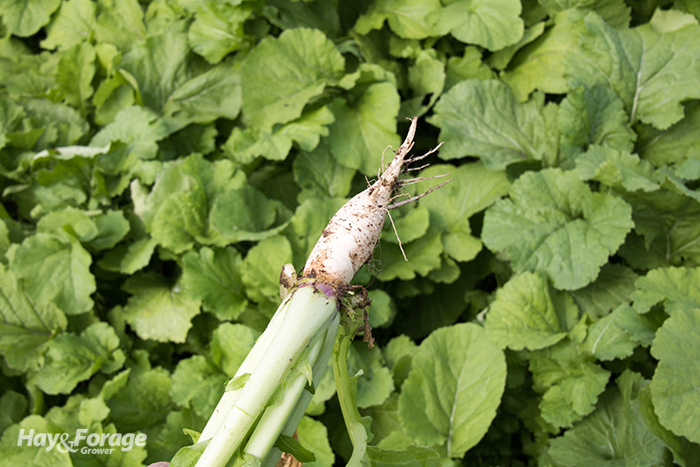Brassicas pack a nutritional punch |
| By Mike Rankin, Senior Editor |
|
|
|
 Pasture managers have a different-looking toolbox than most farmers. Somewhere deep in the corner of those toolboxes, buried under the grasses and legumes, are the brassicas. Although they are not as commonly used as many foundational perennials, annual brassicas can provide a fast, high-quality forage source in just about any type of grazing system. Used in the U.S. for more than 100 years, Mike Trammell explains that brassica crops have been developed by selective breeding and crossbreeding of a few species into many forms designed for different uses as forages, vegetables, oilseeds, and cover crops. Trammell, an Oklahoma State University Extension regional agronomist, says that brassica popularity has been driven by the fact that many farmers are attracted to the idea of improving their soil health while also feeding their livestock. Brassicas include species such as turnips, rape, and kale, but there are also newer additions such as swedes (rutabagas), forage collards, mustards, radishes, and a few interspecies hybrids selected for various traits like the production of high levels of secondary compounds to combat soil pests in crop rotations as cover crops. “The strength of brassicas as a forage crop is their cold tolerance, allowing them to provide high-quality pasture well into the fall and winter when most other forages are dry and brown,” writes Trammell in Oklahoma State’s Cow-Calf Corner newsletter. He explains that brassicas provide minimal new growth after temperatures fall below freezing, but the existing forage persists and holds its nutritional value. Brassicas have an extremely high moisture content and this makes a dry hay harvest nearly impossible. Trammell says that those species forming large bulbs, such as turnips, swedes, and radishes, can be grazed but are less suitable for multiple grazings than varieties that do not elevate their crowns on top of bulbs. “There are turnip and radish varieties selected for grazing that have an increased proportion of top growth relative to the bulb, and livestock readily learn to dig up brassica forage bulbs,” he explains. Brassicas can provide fast forage under good growing conditions, offering emergency feed in as little as 45 days. Yields of brassica forage range from 2 to 5 tons of dry matter per acre, depending on species, variety, and environmental conditions. A nutritional powerhouse Few forage crops offer the extreme nutrient profile that brassicas provide. Crude protein is typically more than sufficient to meet the needs of any livestock class on pasture. Naturally low in fiber compared to grass and legume pasture, the brassicas have a neutral detergent fiber (NDF) range from 11% to 44% and have a NDF digestibility of up to 70%. “Brassicas that form stems such as rape and kales will be at the higher end of the NDF range, while leafy brassicas like turnips and radish will be at the lower end,” Trammell notes. “Due to their high nutritive value, brassicas can produce excellent animal performance but also require adjustments to grazing management.” The forage agronomist suggests that animals should be introduced to brassica-based pastures slowly to allow the rumen time to adapt. Animals should never be allowed to graze pure brassica pastures. To boost effective fiber levels in brassica pastures, plant the brassica in mixtures with small grains (oats, cereal rye, triticale, or wheat) or other grass forages. Additional fiber can also be offered by supplementing pastures with hay or providing access to a separate grass pasture. Trammell cites a good rule of thumb is to limit brassicas to no more than 70% of the diet. Feed the crop Forage brassicas grow best on productive, fertile, and well-drained soils. They do not tolerate wet, saturated soils. Trammell recommends applying up to 100 pounds of nitrogen fertilizer per acre using a split-applied program with applications made both before planting and about three weeks post-planting. Apply phosphorus and potassium according to a soil test. Brassica seeding rates are 2 to 4 pounds per acre for turnips, 4 to 5 pounds per acre for swedes, 5 to 6 pounds per acre for rape and kale, and 4 to 20 pounds per acre for radish. “Although infrequent, brassica crops can cause animal health disorders if grazing is managed improperly,” Trammell asserts. “Most brassica-related disorders in cattle tend to occur during the first two weeks of grazing while adjusting to the forage.” The primary potential disorders Trammell speaks of are polioencephalomalcia (PEM); hemolytic anemia, mainly with kale; nitrate poisoning; and pulmonary emphysema. These maladies can be minimized by limiting brassicas to 70% of the dietary dry matter intake, introducing animals to brassica pasture slowly, never turning hungry animals onto a brassica pasture, providing a trace mineral supplement that includes iodine, not grazing immature rape (safe maturity is indicated by a reddish/bronze tint to leaves), and avoiding excessive nitrogen and sulfur fertility. |
